|
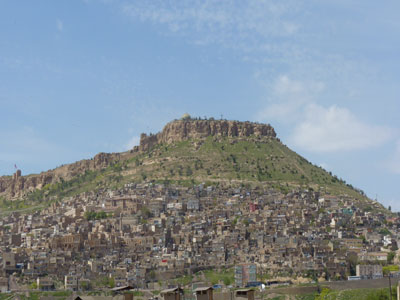 |
Mardin is situated on a hilltop overlooking a 270-kilometre-long plain in the southeastern Anatolian region, hence the amazing view on the Mesopotamian plain down to the Syrian territory whose border is around 20 kilometres away. Mardin is located in the province of the same name between the Tigris and Euphrates rivers in the Upper Mesopotamian basin. This area used to be called by ancient Greeks “the country between two rivers”. It was considered as one of the major depository of grains. Because of its rich soil, it was the birthplace of many civilisations. Agriculture and animal husbandry began in this basin and the earliest legends originated here. The legends of Noah’s Flood, the Prophet Idris (known in the Bible as Enoch), and many others are attributed to this land. |
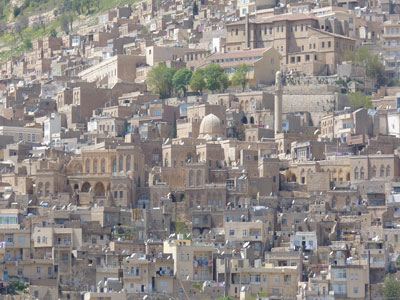 |
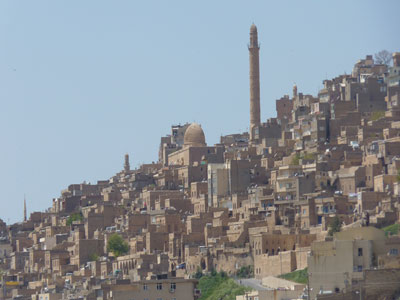 |
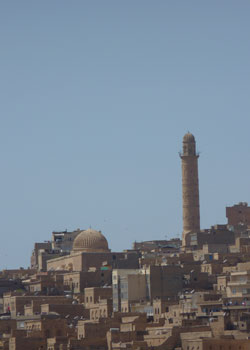 |
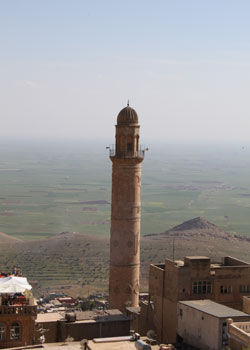 |
The population of the city is around 65,000 people from various origins - Kurds, Turks, Assyrian/Syriacs, Armenians and Arabs. Mardin is one of the rare cities of the world where several religions such as Islam, Christianity, Judaism, and Yezidism can be found.
The city has an important place in History. From the 3rd century until 640, it was lived in by Syriac Christians. In 640, it was invaded by the Arabs. Indeed, Mardin was conquered by Muslim Arabs during the caliphate of Umar. In the 7th century it came under the dominion of the Ummayads and in the 9th century under the Abbasids’. Thus Islam spread throughout the region which experienced the most brilliant period of its Islamic identity during the Artuqid era. In a history extending from the Sumerian era to the Republic of Turkey, the Artuqid era is important from the aspect of Mardin’s urban identity. The architectural configuration that has remained since the 12th century is mainly the result of constructions dating back to the period. In the 12th century, the city was taken by the Seldjoukides before its entrance in the Ottoman Empire in 1516. At the beginning of the 19th century, Mardin was destroyed several times after Kurdish rebellions and an occupation by Egypt in 1839.
Along with Venice and Jerusalem it is one of the three cities with the best preserved historical architecture in the world. Today, Mardin, located on the Silk Road, has several inns and caravanserais and its 15 mosques and almost as many churches reflect the characteristics of the periods they were built in.
|
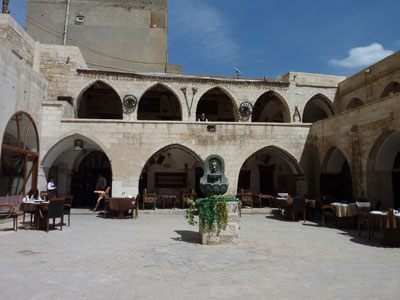
A caravanserai
|
| We visited one of these mosques in Zinciriye Madrasa located just underneath the castle. This madrasa was commissioned in 1385 by Melik Necmeddin Isa who was later imprisoned in this madrasa also known as the “Madrasa of Sultan Isa”. It is a two-storied building and it has two courtyards. It also hosts a mosque and the tomb of Sultan Isa. |
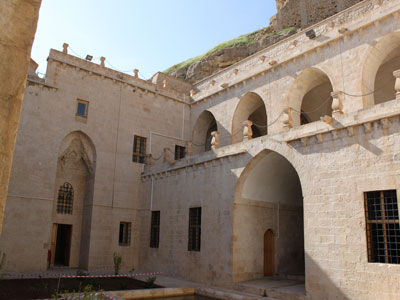 |
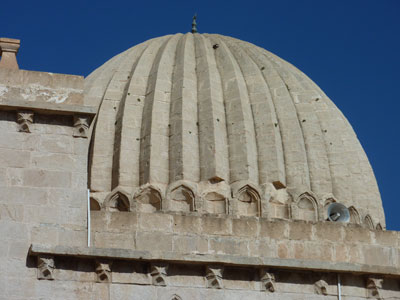 |
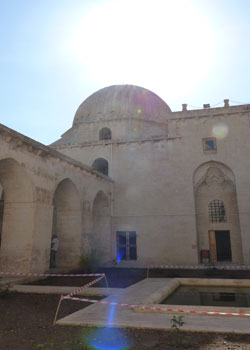
|
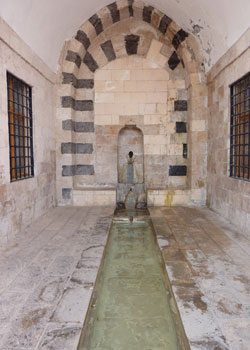
Zinciriye Madrasa
|
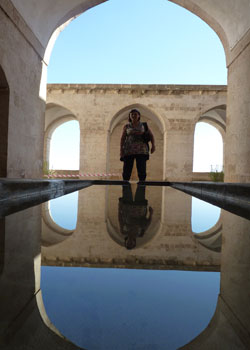
|
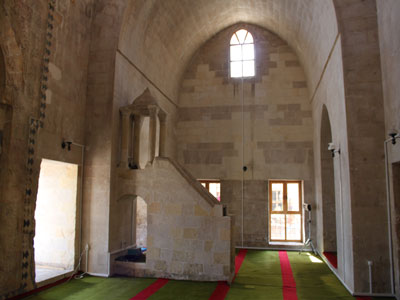
The mosque and its minbar |
THE LEGEND OF ZINCIRIYE MADRASA : THE MAGIC OF CHAIN
As Mardin region is a dry region there are many snakes and scorpions which are poisonous. So these snakes and scorpions bit many people who died, particularly so as many people used to sleep on roof tops during hot summer nights. To put an end to this plague, people decided to ask wise religious people for advice. The latter advised their fellow citizens to write prayers for scorpions and snakes not to bite anyone else and told them to tie up these written prayers to a chain which they hung from the top of the minarets of two mosques. As one of the minaret collapsed, they then tied it to the top of Zinciriye Madrasa and laid the prayers on Sultan Isa’s tomb. But unfortunately the chain was stolen during the Second World War. Yet it is believed that because the written prayers were laid on the tomb of Sultan Isa the city was still being protected from scorpions. Since then on there have been no more reports of snake and scorpion bites and people say that the local hospital’s registers can confirm it.
MARDIN CASTLE
Mardin is also famous for its castle, standing on the hill dominating the city and crowned with superb stonework. It is known as the “Eagle Nest” due to its protected position. It was built in 975-976 AD by Abdullah Bin Hamdan of the Hamdani. It is 1200 metres above sea level and is between 30 and 150 metres wide. This fortress played an important role at the time of Subaru, Sumerians, Babylonians, Assyrians, Persians, Romans, Byzantines, Ottomans and many more. It is also clear from the reports of travellers who came to Mardin at these different periods of time that there were many additions inside the castle including storage barns, wells and bathhouses. Unfortunately it cannot be visited since it is now a military base. |
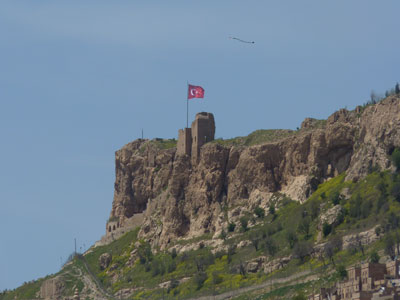 |
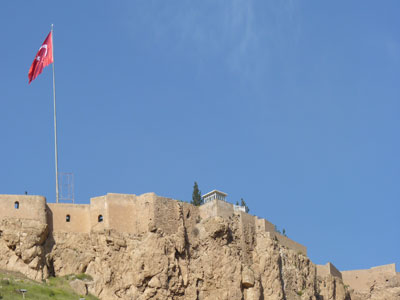 |
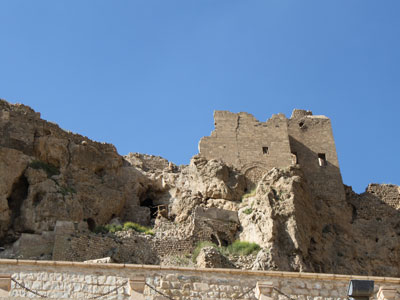
|
THE LEGEND OF MARDIN CASTLE
It is believed that once upon a time, a king named Şad Buhari - who was a fire and sun worshipper - came and stayed in Mardin. The king who was ill recovered during his stay and thus decided to have a summer palace built on site. He lived there for 12 years. He brought his people and soldiers from Persia and Babel. Those people contributed to the improvement of the city. Then, in 442 AD because of the plague epidemic in the castle, all the people died and the castle remained empty for a long time. |
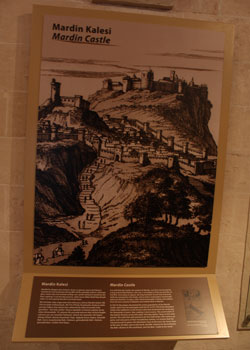
|
THE STREETS OF MARDIN
On our way to the museum we were able to take a look at the narrow streets going uphill... |
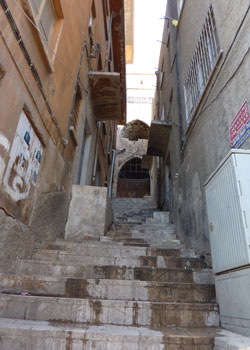 |
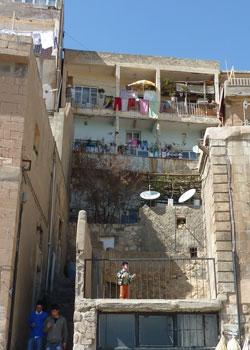 |
... at traditional shops, such as a soap shop... |
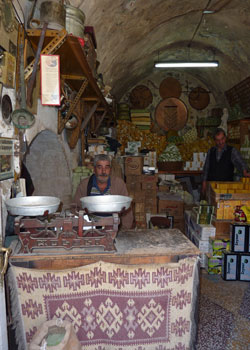
|
| ... a bakery where the baker was making Turkish pizza... |
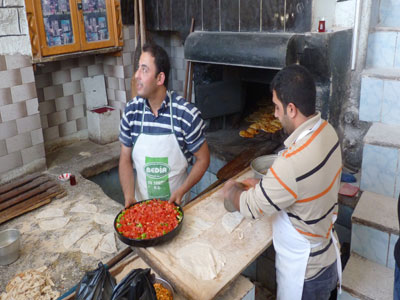 |
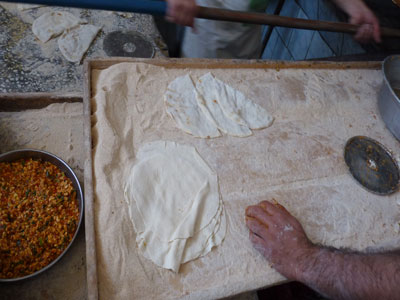 |
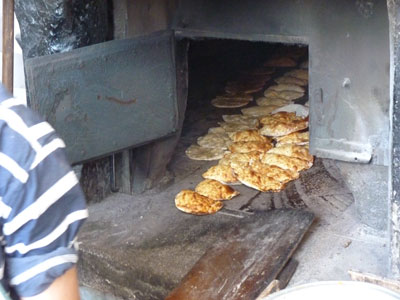
|
| ... a local souvenir shop... |
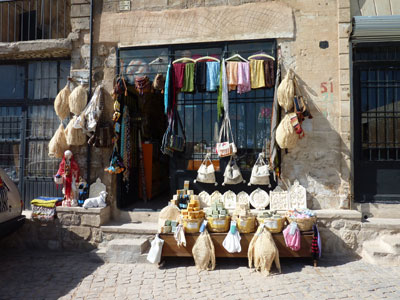 |
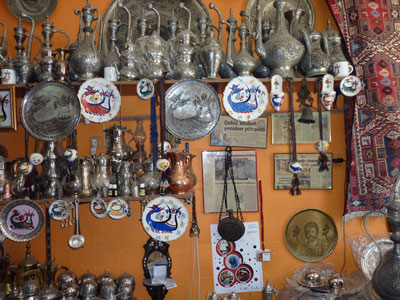 |
... a clothes shop...
|
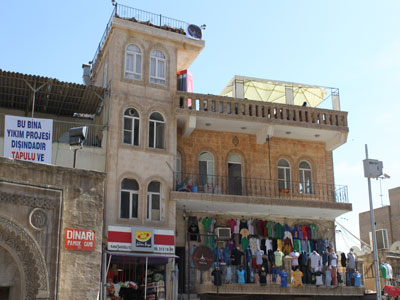
|
| ... or a shop selling “ayran”, a typical Turkish yoghurt. |
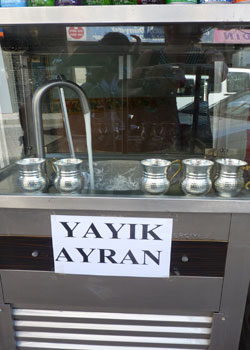 |
MARDIN MUSEUM
The building hosting Mardin museum was originaly built as the Church of Virgin Mary, a Syriac Catholic church (1895). It became a museum in 1995. It displays many ethnographical and archaeological items a lot of which were excavated from Gιrnavaz Mound. It houses ceramics, seals, cylindrical stamps, coins, lamps, figurines, jewelry and many other pieces belonging to the Early Bronze, Middle Bronze and Late Bronze Age, the first Iron Age, Assyrian, Urartian, Persian, Roman, Byzantine, Seljuk, Artuqid and Ottoman periods. |
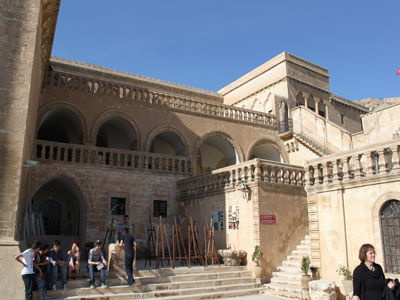 |
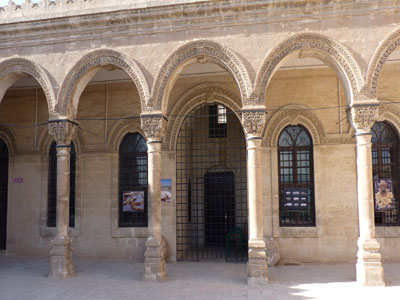 |
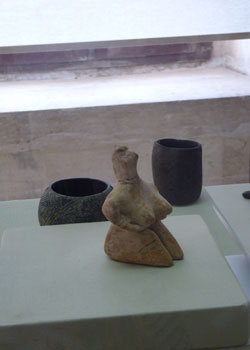 |
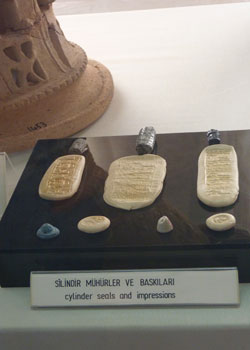 |
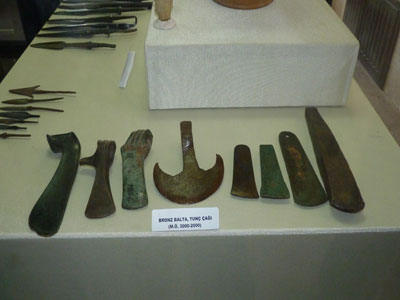 |
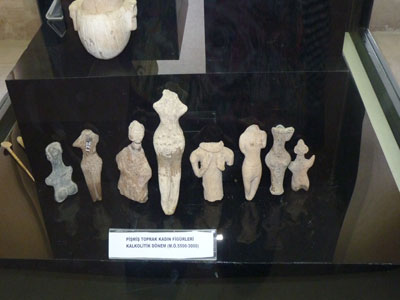 |
SAKIP SABANCI MUSEUM
Sakιp Sabancι Museum opened its doors on October 1st, 2009. It is situated in a historic building (formerly army barracks).
|
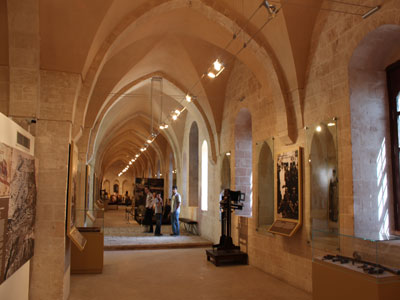 |
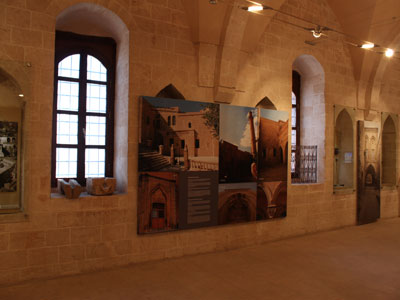 |
| This new museum was particularly interesting as it allowed us to collect essential information about Mardin and its surroundings, the spread of Christianity and Islam in the region... |
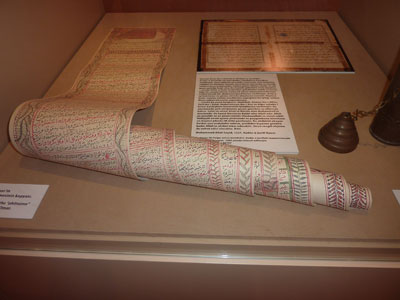 |
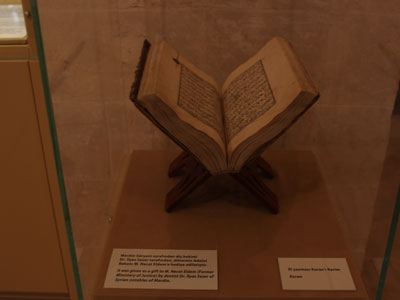 |
| ... about the Silk Road... |
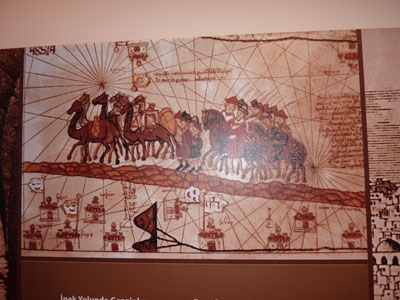 |
| We were also able to learn about traditional crafts... |
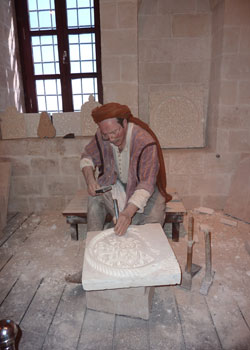 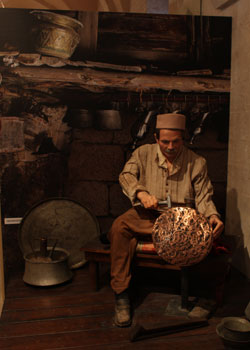 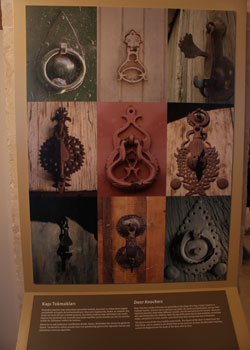 |
| ... customs such as the Hamam Culture or the use of “taht” - on hot summer nights, life continues on the rooftops, where the residents of mardin enjoy cooling off lying on these sort of large divans with low railing on three sides, made of ash and covered in white fabric. |
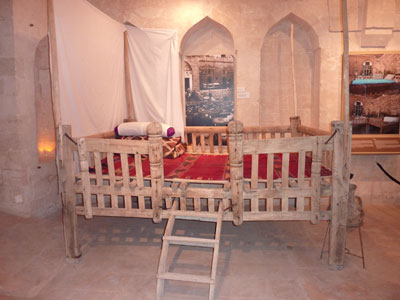 A "taht" A "taht" |
| |
THE LEGEND OF ŞAHMERAN
The legend of Şahmeran comes from Mesopotamia. It has been told and retold in Mardin for hundreds and hundreds of years. The name "Şahmeran" actually comes from the Persian name "Şah-ι Meran," which means "the shah of the snakes". Şahmeran was half a snake and half a very beautiful woman. She was a snake from the waist down, but from the waist upwards, a beautiful woman. Her portraits are traditionally hung on walls inside houses especially on girls’ bedroom walls. It is believed that hanging her pictures brings good fortune for them.
Şahmeran : a love story
Once upon a time, there was a tall and handsome boy called Tahmasp who lived in Mardin. One day, by mistake, he walked into a cave where thousands of snakes were sleeping. There he met Şahmeran.
Tahmasp couldn’t hide the fact that he was attracted to her although she was a snake from the waist down. Tahmasp remained in the cave for days on end, listening to Şahmeran tell incredible stories about the world and humanity. He was rapt, but when Şahmeran had told him everything and there was nothing left to tell, Tahmasp decided that he was missing the outside world and left. Even though Şahmeran didn't like this idea, in the end, she accepted it. |
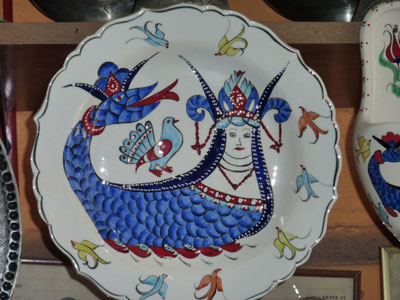 A representation of Şahmeran A representation of Şahmeran
|
| So Tahmasp returned to the land where he used to live. But one day, the king of that land got very ill. One of the king's assistants who was quite evil told the king that the only treatment that would cure him was to eat a piece of meat from the body of Şahmeran. The search began. Anyone who might know anything about Şahmeran was asked to come forward. One day, as Tahmasp was at the hamam, he was identified by soldiers who spotted snake scales all over his body. The soldiers brought him to the king's evil assistant. It turned out - not surprisingly - that the wicked royal aide's real aim was not to make the king better, but to hear about the secrets of the world straight from the mouth of Şahmeran. Following his orders, Tahmasp was tortured until he revealed the location of Şahmeran's cave. So the assistant and the soldiers went to the cave and found Şahmeran who revealed her great secret, saying: "Whoever tears off a bit of flesh from my tail and eats it will be endowed with all the secrets of the world. But whoever takes a bit of flesh from my head and eats it will die instantly." No sooner were these words out of Şahmeran's mouth than the villainous assistant cut the half-snake, half-woman into two pieces, and ripped a bit of flesh from her tail. Tahmasp, horrified by what he had just witnessed, bit into a piece of flesh from Şahmeran's head so as to die immediately. But what happened instead is that the king's evil aide - having eaten a bite of Şahmeran's tail - died on the spot while Tahmasp appeared completely unaffected. Thus it turned out that Şahmeran had anticipated the king's assistant’s plot and had seen to it that her lover, Tahmasp, inherited all her knowledge, while her enemy went to his death. However, in the wake of Şahmeran's death, Tahmasp was so bereaved that he isolated himself away from the rest of humanity. He became a legendary doctor, Lokman Hekim. This created a new legend, the legend of Lokman Hekim. |
|
| THE ANTIQUE CITY OF DARA |
| Around Mardin, there are many historical structures that date back to the era of the Persian king Darius. Now called Oğuz, Dara is located at the border between Syria and Turkey 30 kilometres southeast of Mardin. |
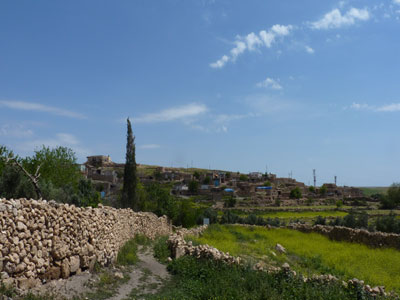 |
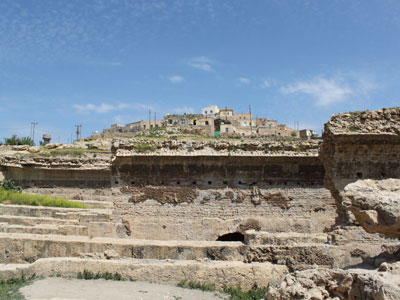 |
| |
It was named after its founder - the emperor Darius the first. It is an old Byzantine fortress which was established in the 6th century before Christ. It was first constructed as a summer residence - the Persians spent their winters in Mardin inside the fortress and their summers on the plain bellow. At that time, Mardin was known as “Taht-ι Dara” (Below Dara). Dara was also used as a garrison city to defend the eastern borders of the Eastern Roman Empire. It was occupied by many civilizations such as the Greeks, the Romans, the Parthians, the Byzantines and the Sassanids. In the years 506-507, the city was fortified by Anastase I who renamed the city Anastasiapolis. Kavadh I criticized this act which he considered as a mark of hostility and breaking of the peace between the two countries. In the year 530, the emperor Belisaire won a battle against Kavadh I just behind the walls of the city. The son of Kavadh I, Khosro I Anushîrvan, signed an eternal peace treaty with the Byzantine emperor Justinian. In the year 540, Khosro I resumed the war and lost it. After his defeat he agreed to leave the city against a payment. Khosro I came back in 573 and took the city after a siege of four months.
Dara consists of buildings that were carved into the rock and was once protected by 4 kilometres long fortifications. The inner castle was situated to the north of the city. Although the city is now in ruins, the remains of a church, the agora and the old cisterns can still be seen nowadays. |
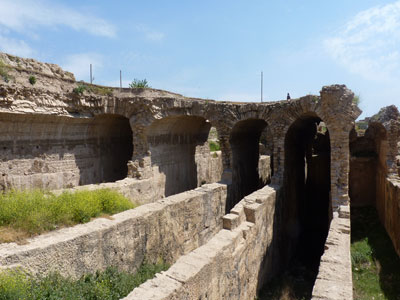 The old cisterns The old cisterns |
| This mainly underground building is referred to as “the prison” by locals, but its architectural form and measurements indicate it must have been used as storage. It dates back to 600 AD. |
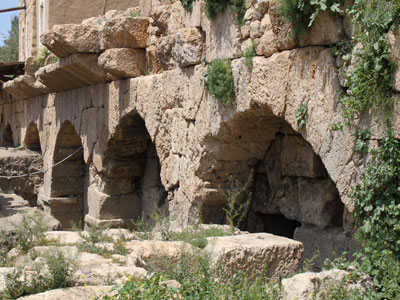 “The prison” “The prison”
|
| There is an underground place on the outskirts of Dara the use of which is still unknown. In fact, it could have been used as a jail, a meeting place for the soldiers or an underground church. The most probable use is the church because of the high roof. The only thing known about this place is that it is nearly 20 metres high and to go down you have to take a 53-stepped staircase. |
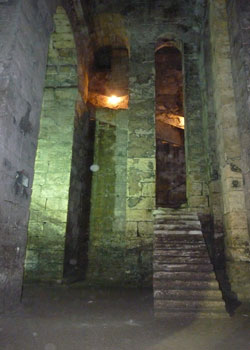
The church
|
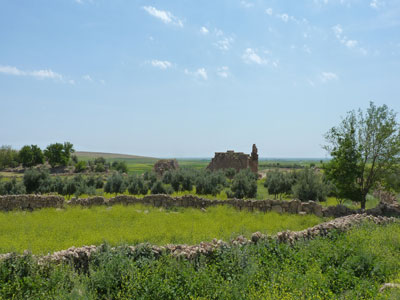
The city walls and tower |
Dara is the first place settled in by the Kurdish.
Outside Dara, cave houses dating back to the late Roman period can still be seen. |
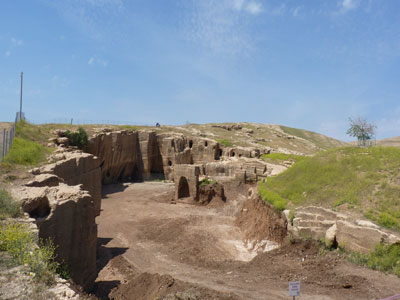 Cave houses Cave houses
|
This quiet village was for us the occasion to have a drink of “ayran” and an improvised international workshop...
|
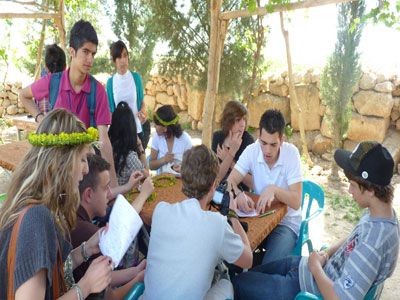
|
| ... and to meet with the local population, and schoolboys and schoolgirls in particular. |
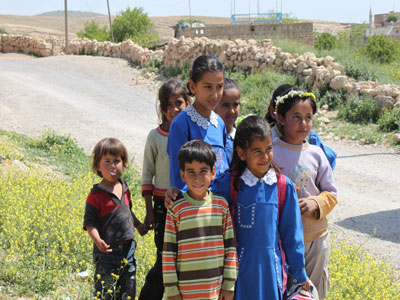 |
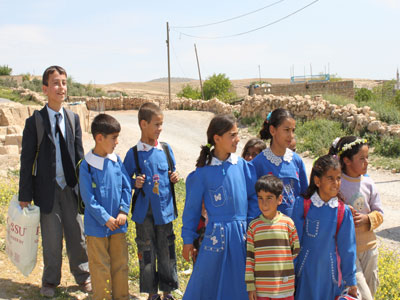 |
|
DEYRULZAFARAN (OR MOR HANANYO) MONASTERY
Christianity became widespread in Mesopotamia during the 3rd century which accounts for the existence of numerous monasteries in the region, some of which are still active. |
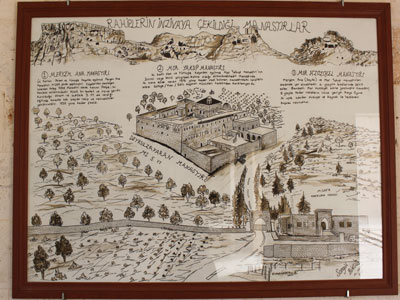
|
| Also called the Saffron Monastery for the colour of the stone, Deyrulzafaran Monastery is located 3 kilometres east of Mardin and it is the most important monastery of the region. |
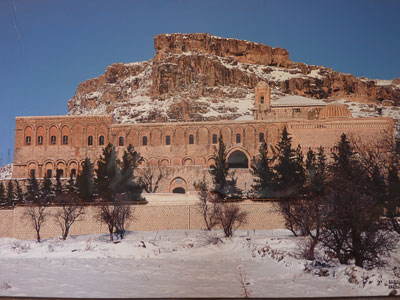 |
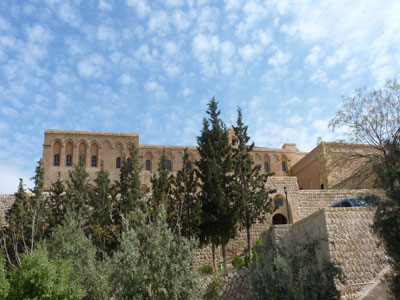 |
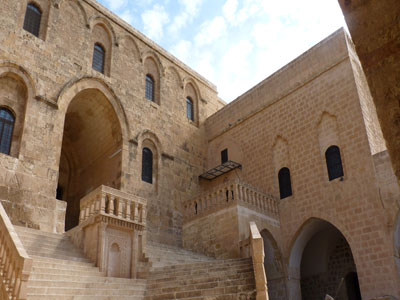
|
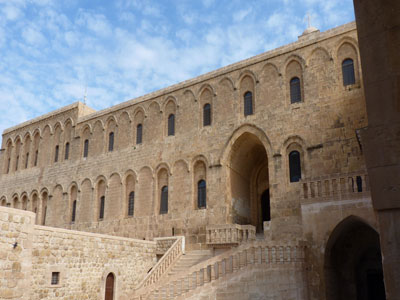
|
It was built in the fourth century on an old temple of the admirers of the sun that can still be seen with its impressive roof composed of 2-metre-high stones. These stones weigh between 500 kilos and 1 ton and hold together without mortar. In the wall there is a window through which the sun penetrated in the morning. When the sun reached the altar opposite it, a sheep or another animal was sacrificed.
|
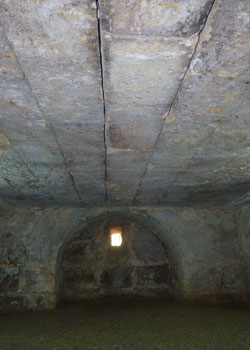 The sun temple The sun temple
|
It was later turned into a castle by the Romans, but after Christianity became the official religion, churches were built in it. And when the Romans withdrew from the region, St Şleymun brought the
relics of some saints to the castle which was then converted into a monastery. It was the residence of the Syriac Orthodox Patriarch for 640 years, until 1932. In 793, the monastery - then known as Mor Şleymun Monastery, underwent extensive reparations undertaken by the Metropolitan of Mardin, Mor Hananyo, and was thereafter known as Mor Hananyo Monastery. It’s only after the 15th century, that it was called Deyrulzafaran.
In the monastery there is an indoor graveyard in which 52 orthodox Syriac patriarchs are buried in seated position facing the east. The graves date back from 495 AD.
|
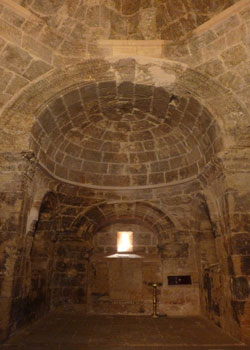 The indoor graveyard The indoor graveyard
|
| Special ceremonies on Wednesdays, Fridays and Sundays are celebrated in Saint Hanani church as well as the normal ceremonies of morning and evening. In this church old pictures (1200 years old) of Saint Hanani and pictures of Jacob from the year 1910 can be found. |
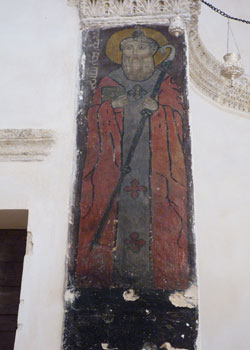
Saint Hanani
|
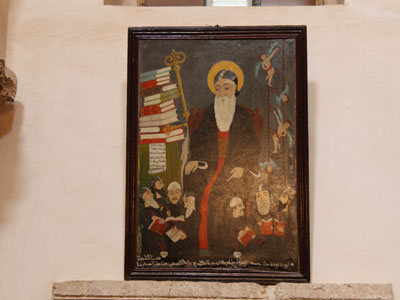
Jacob
|
In the monastery there is a second church - Virgin Mary Church - which is only used on the 15th of August and when children are christened. In this church we can see a printing machine given by Queen Elisabeth I which was the second printing machine in Turkey.
The monastery - which is said to have held the first medical school - still has a great importance and meaning for the Syriac Orthodox church. In fact, today, a large percentage of the Christian community in the region of Mardin is of Jacobite belief and members of the Syriac Orthodox Church.
|
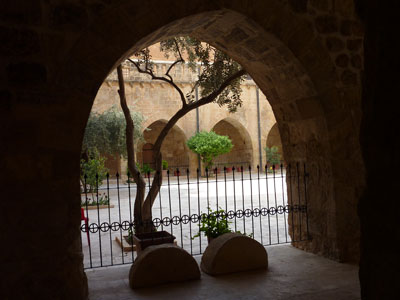 |
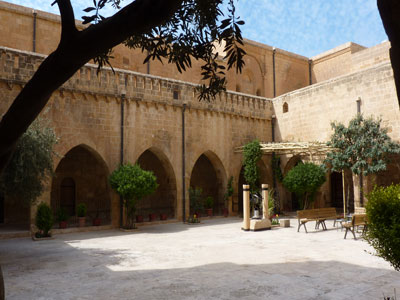 |
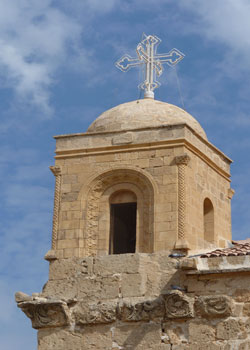 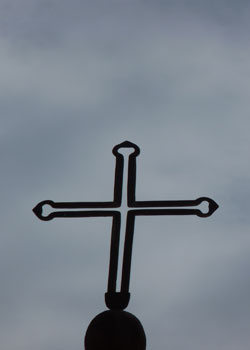 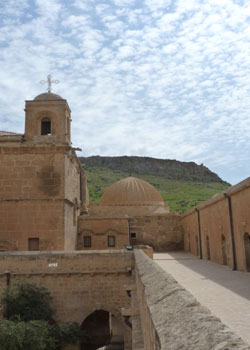 |
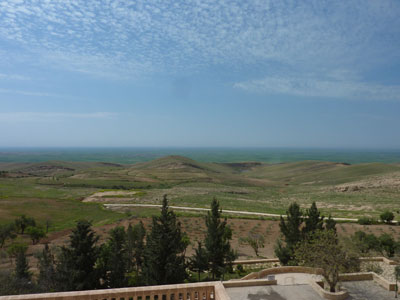 |
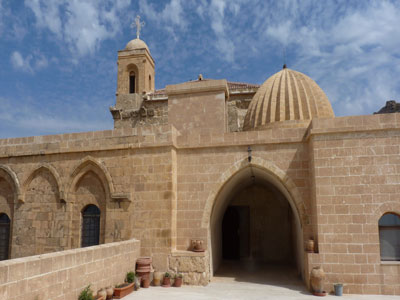 |
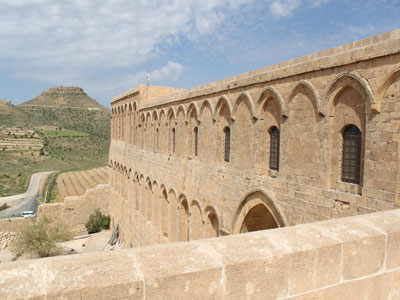 |
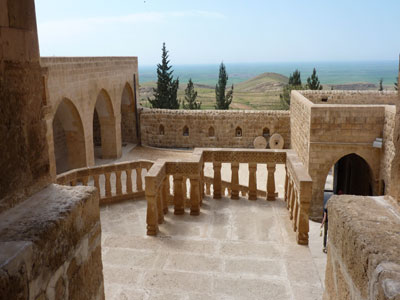 |
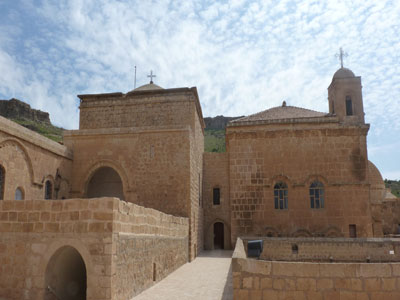 |
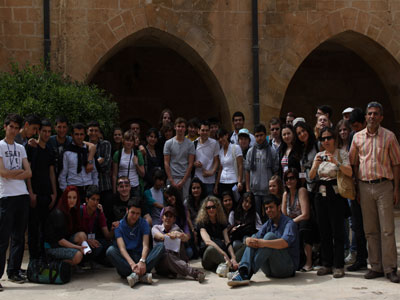 |